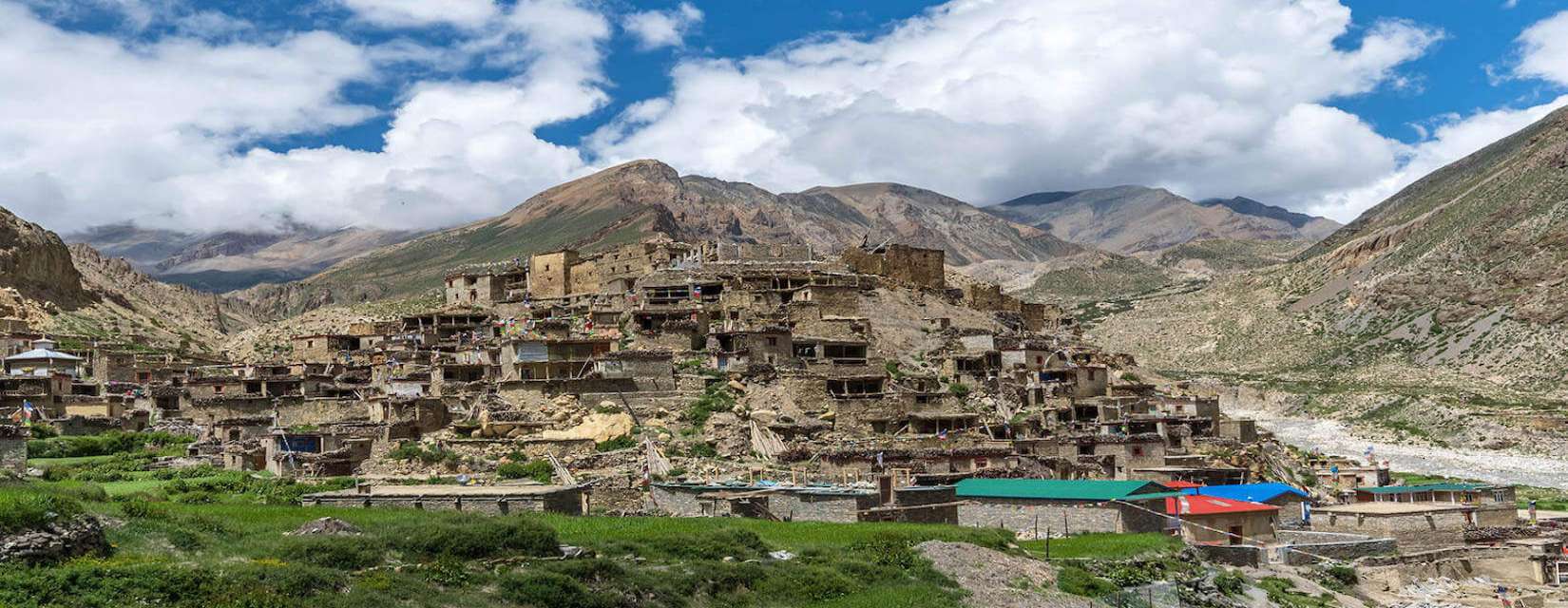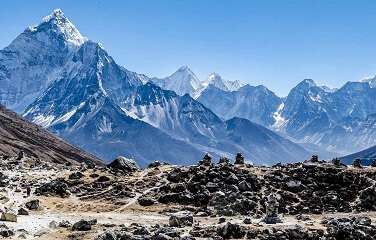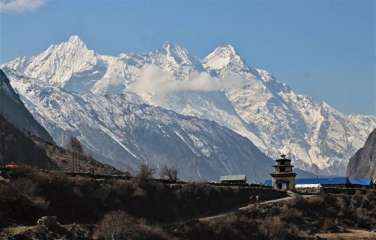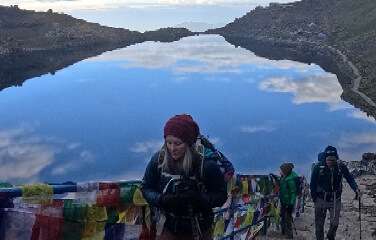Around Annapurna Circuit Trek via Nar Phu Valley Route

We start the Around Annapurna Circuit Trek via Nar Phu Valley Itinerary from UNESCO World Heritage Sites in Kathmandu, then take the long and scenic drive to Jagat, from here, trekking head toward to north into the narrow Nar Valley. The trek goes through the lush forest and rock walls, likewise, you will see the ancient valley of Nar and Phu as well as discover the scenery broadens and traditional culture. From Nar village, you'll walk the ascent rock trail to Kang La Pass, which offers an adventure experience with amazing landscapes. Then the trail descends Nagwal and Manang, then goes to Tilicho Lake. Further, the trail moves up through cliffs and reaches Thorang Phedi. The next day, early morning the trail ascends through a steep and rugged path to reach Thorong La Pass. Upon reaching Thorong La Pass, you get to see outstanding landscape views. Further, the trail descends to Muktinath Temple, which is a very famous pilgrimage site in Nepal. From Muktinath, you descend and pass by Kali Gandaki gorge to Jomsom, from here, you will fly back to Kathmandu via Pokhara.
Hidden Valley Nar & Phu and Annapurna Circuit Trek Highlight
- A day sightseeing around UNESCO World Heritage Sites in Kathmandu.
- Explore the remote part of Nepal, Nar and Phu Village.
- The traditional culture of Hindus and Buddhists.
- Wide range of flora and fauna.
- Visit the beautiful villages of Nagwal, Chame, Manang, and Mustang.
- Discover the world's highest Tilicho Lake.
- Crosses the famous Himalayan pass Thorong La and Kang La.
- Magnificent mountains vista of Dhaulagiri range, Manaslu, Annapurna range, Himlung Himal, Tilicho Peak, Gangapurna, etc.
- Visit the holiest temples of Hindus, Muktinath.
- Scenic flight from Jomsom to Pokhara.
- Pokhara Valley Tour.
Nar Phu and Annapurna Circuit Trek details Itinerary
Day 01:Arrival in Kathmandu Nepal
As you arrive at the Tribhuvan International Airport, you will get greeted by the representative of Himalayan Frozen Adventure. He/she will take you to the hotel that we have already booked for you in the advance. You get informed about the evening plan with some spare time to relax.
To welcome you, the company has organized a traditional welcome dinner along with cultural dance. You will meet with other team members over dinner and end the day with lots of laughter.
Day 02:Kathmandu sightseeing and trek preparation
We have designed a short yet wonderful guided tour during which you visit UNESCO World Heritage Sites like Pashupatinath Temple, Boudhnath Stupa, Swayambhunath, and Kathmandu Durbar Square. The tour presents deep insights into the history and diverse culture of Nepalis. After the tour, you prepare for the trip. You and your guide will check all the gears and documents and do the final packing.
Day 03:Drive from Kathmandu to Jagat 1,100m, 8-9 hours
After having a warm breakfast, you drive towards Jagat. It is going to be a long drive, therefore you drive early. On the way, you get to see wonderful scenery like lush green hills, rivers, colorful terraced fields, and small settlement areas. From Besishashar onwards, the road gets dusty and bumpy up to Jagat.
Day 04:Trek from Jagat to Dharapani 1,960m 7-8 hours
After having a warm breakfast at Jagat lodge, you walk along the Marsyangdi river and reach beautiful village Tal, where you can see amazing waterfalls and walk through the wonderful farm's area of potato, barley, and rice fields. Similarly, you leave beautiful settlements of Manang district, then ascent to reach Dharapani, where you stay overnight at Dharapani Lodge.
Day 05:Trek from Dharapani to Koto 2,610m, 5-6 hours
You wake up early and begin trekking towards Koto. Passing by Bagarchhap, you walk through lush pine & fir forest. The trail further leads you to Danaque and steeply ascends towards Timang. On the way, you get to witness stunning views of Peak 29 and Mt. Manasalu. The trail again moves by lush forests and climbs up to Koto village.
Day 06:Trek from Koto to Meta 3,560m, 7-8 hours
After having breakfast, You register your permits before moving towards Meta. The trail moves along the bank of Soti Khola and goes through dense forests. Crossing a few streams and suspension bridges, you ascend on the steep forested path and reach Meta. The trail offers fantastic views of Lamjung Himal and Annapurna II.
Day 07:Trek from Meta to Phu Gaon 4,250m, 7-8 hours
After a few ascends and descendants, you will cross several suspension bridges. The trail will take you to Kyang, where you get to see remnants of the Khampa settlement. From here, you walk along Phu Khola on a rugged path and reach Phu village. You get to see the beautiful landscapes on the way to Phu village.
Day 08:Acclimatization at Phu Gaon 4,250m
Today is your rest day at Phu village. You will explore the village, Himlung Base Camp, and spend time observing the culture and traditions of the locals. You will visit the ancient Tashi Lhakhang monastery, which is listed in the list of 108 world's old monasteries. This monastery is believed to be the last monastery built by Karmapa Rinpoche.
Day 09:Trek from Phu Gaon to Nar 4,110m, 6-7 hours
After having breakfast, The trail descends and crosses a few streams and suspension bridges until you reach Mahendra Pul. From here, you will cross a high thrilling suspension bridge over the Lapche river gorge. You will then ascend by numerous stupas and reach Nar village. From the village, you get to see stunning views of Pisang Peak and other surrounding mountains.
Day 10:Acclimatization and preparation at Nar 4,110m
Today is another rest day in Nar village. The day goes the same as before. You explore the village and its nearby areas. You will look into the daily lifestyle of the locals and their culture.
Day 11:Trek from Nar to Kang La Pass 5,322m to Ngwal 3,660m, 7-8 hours
It is going to be a long and tough trekking day. The trail ascends to Kang La Pass from where you get to see wonderful landscapes and views of the Annapurna range. After spending some time at the top of the pass, you drop down to Ngwal to spend the night.
Day 12:Trek from Ngwal to Manang 3,540m, 4-5 hours
Leaving Nagwal behind, you walk by the isolated Paugh village that offers an excellent view of the Annapurna range. From here, the trail gradually ascends to Mungil and leads you to Manang. Here, you will visit ancient monasteries and stupas.
Day 13:Acclimatization day at Manang
Today you have acclimatization to visit side hike of Manang and make altitude fitness for the high pass. There are two amazing lakes Gangapurna Lake and Ice lake. Similarly, you can explore the ancient monasteries, Manang village, and enjoy with an amazing view of Mt. Annapurna range, Gangapurna, Tilicho Peak, etc. Overnight you stay at same trekking lodge.
Day 14:Trek from Manang to Khangsar 3,745m, 3-4 hours
The trail continues towards Khangsar. Descending through a gorge, you move ahead enjoying Tilicho Peak's views. The trail will further offer stunning landscape views. Further, passing through a small scenic settlement area, you reach the Khangsar river and reach Khangsar village.
Day 15:Trek from Khangsar to Tilicho Base Camp 4,140m, 5-6 hours
Today, you move towards Tilicho Lake Base Camp. The trail passes through wide grassy fields and ascends to a small hill from where you can see the entire view of the valley. From here, the trail descends along a steep path and takes you to Tilicho Base Camp.
Day 16:Visit Tilicho Lake 4,949m and trek back to base camp 4,140m, 5-6 hours
You will wake up early in the morning and ascend on a moraine & move along the hillside. While trekking, you get to see fantastic views of Mt. Nilgiri, Tilicho Peak, and many other Himalayan mountains. The trail will take you to Tilicho Lake where you will see breath-taking views. After spending some time at the lake, you drop down to the base camp for a night stay.
Day 17:Trek from Tilicho Base Camp to Yak Kharka 4,040m, 4-5 hours
Today, the trail leaves the Marsyangdi Valley and ascends to Yak Kharka. Now, you will find yourself amidst more alpine vegetation. Crossing a log bridge, you reach Yak Kharka that offers a wonderful view of Annapurna III and lovely yaks grazing lands.
Day 18:Trek from Yak kharka to Thorong Phedi 4,420m, 3-4 hours
After having breakfast, you walk through a small settlement and cross the suspension bridge, leaving a teahouse, then ascend an hour of a steep climb to reach Thorong Phedi, where you spend overnight.
Day 19:Trek from Thorong Phedi to Muktinath 3,800m, 7-8 hours via Thorong La pass 5,416m
Today, the day begins early. You will be crossing the challenging Thorong La Pass. From Thorong Phedi, the trail ascends through a steep and rugged path. Upon reaching Thorong La Pass, you get to see outstanding landscape views. Further, the trail descends to Muktinath Temple, which is a very famous pilgrimage site in Nepal.
Day 20:Trek from Muktinath to Jomsom 2,715m, 5-6 hours
The trek to Jomsom is a most exciting route and easy, after having breakfast at Muktinath, you walk down to Kali Gandaki river valley with a small break at Eklaibhatti and cross the beautiful villages of Jharkot and Kagbeni, then you reach Jomsom, where get to see mountain views of Nilgiri North, Tukuchey peak, Dhaulagiri massif, etc. Overnight you stay at Jomsom trekking lodge.
Day 21:Fly from Jomsom to Pokhara 823m, 30 mins
Today, you will take a morning flight back to Pokhara after having breakfast. The flight offers breath-taking views of Annapurna and Dhaulagiri massifs. Upon landing at the airport, you head to the hotel. You can enjoy exploring the rest of the day.
Day 22:Drive from Pokhara to Kathmandu 1,300m, 7-8 hours
We leave Pokhara at 7:30 by tourist bus; a scenic drive from Pokhara to Kathmandu will take between 7/8 hrs. It's a 200km distance; we follow through the drive Trishuli River and Marsyangdi River.
Day 23:Final departure
You will fly back to your home. One of our team representatives will take you to the airport as per your flight departure time.
Nar Phu Valley Trek FAQS

Is Nar Phu Valley Trek Difficulty?
Yes, Nar Phu Valley Trek is Difficulty through the Kang La Pass (5,322m) and Thorong La Pass (5,416 m). This trek Difficulty is classified as moderate, who has good healthy fitness, perfect training, and already has done trek above 3000m, those trekkers can do easily this trek.
Is it necessary to need travel Insurance for this trek?
The travel insurance will cover emergency evacuation as Helicopter rescue and the hospital charge. If you fell an accident and Acute mountain sickness then, at this condition, your travel insurance will immediately provide the helicopter.
Electricity does available on Nar Phu Valley Trek?
Yes, electricity is available in the lower region of Annapurna trek, where you can get to charge your camera and mobile batteries, etc. But high elevation there has a solar system power so it's not enough for the charge. So we suggest you take some extra batteries for this Nar Phu Valley Trek.
Is possible to take my children to Nar Phu Valley Trek?
Of course, all of the age can do it but before goes trekking, you have to give hard training for your child.
Is possible to get a hot shower the trekking?
Yes, the hot shower is possible to get many lodges and teahouse but above the 4,000m is not available and not good for your health.
Can I found Wi-Fi through the trek?
Of course, Wi-Fi is available many lodges and teahouse, but you have to pay extra.
Is it safe for a solo female traveler?
Of course, the solo female traveler is fully safe, Himalayan frozen Adventure is responsible teams, who leading many solo trekkers through the Himalayan and made successfully.
How can I respect the culture?
During the trekking, we can get see amazing culture, there we can see some notice, we have to follow that notice rule and regulation.
Is possible to get ATM through trek?
No, is not possible to get ATM and bank through the trek, so you have to takes Nepali money from Kathmandu.
Do I have to take sleeping bags on the trek?
Yes, is necessary to take sleeping bags on the trek because the lodges don't have enough blanket.
How high the Nar Phu Valley Trek?
Nar Phu Valley Trek elevation is (5,416m) above the sea level.
Is Nar Phu Valley Trek permits necessary?
Yes, we need a special permit Annapurna Conservation Area Project(ACAP), and Trekkers’ Information Management System (TIMS) permit is necessary for this trek.
How many hours I have to walk each day?
For this trek per day maximum of 7 hours and a minimum of 5 hours, you have to walk.
Is possible to make an extra day on the trek?
Yes, if you have time then the trekking is always flexible, you can easily add.
Without any trek can I do it?
Yap, many trekkers success without any trek but you have to use 2 - 3 acclimatization days through the trekking. Himalayan Frozen Adventure recommend you before going to the trek, you have to need training. If any information needs about this trip please kindly contact us.
Booking trip can I do cancel?
Yes, you have the option to cancel this trip but there are some certain conditions:
- If you cancel your trip before 60 days the full amount will be refunded
- If you cancel your trip before 30 days the 30% amount will be refunded.
- If you cancel your trip before 1 week the 5% amount will be refunded.
How to manage drink water through trekking?
The Annapurna region can get normal free tap water, for this water you have to use purification medicine. Bottled water or boiled water also available to buy at lodges and teahouse. Per day you have to drink about 4-6 liters water for your health.
Is possible to pick up me from the airport?
Yes, when you arrive at Kathmandu International Airport, our airport representative will wait for you at the airport, we will display a Himalayan Frozen Adventure with your group name signboard outside the airport terminal. You will be then transferred to your respective hotel in our car.
Can I exchange my money in Nepal?
Of course, You can exchangers your money at the Airport, ATM, and money exchange by a better rate. And you can get enough Nepalese cash for your trek.
What do I have to carry on the trekking?
You have to carry the perfect size trekking bag where you can put your personal belongings item, snacks, sunscreen, water, camera, gloves, hat, and jacket. Our porter will carry your 20 kg bigger packs.
Is possible to store my extra things in Kathmandu Hotel?
Yes, it's possible to store your extra things in Kathmandu Hotel, We have a safe place to store your luggage.
Can I get an experienced guide?
Of course, we'll provide an experienced guide, who has the deepest information about Himalayan Nepal, and government license holder English speaking guide. Our guide and porter are fully helpful and friendly and make your trip fantastic.
Safe to Travel
Make you safe to travel is our top priority responsibility

During the trek, you will be the best training and experienced guide, who came from the high region of Himalayan. Our guide will carry all necessary paper and essentials equipment with a first aid kit. In case, if our clients come to some emergency problems of mountain sickness and accident then we immediately send a rescue helicopter. Any region of the Himalayan treks will demand good health and fitness, so make healthy your body before joining the trip.
Trekking Guide
We, Himalayan Frozen Adventure provides the deepest knowledge leader through the Himalayan Trekking, who has the ability to face challenges. The Nepal route is an adventure challenge where has different types of risks. During the trekking, you have might some risks like altitude sickness, weather conditions, wildlife attack, and Fear of getting lost. But don't worry, the guide will solve this problem and make you feel safe with a free and delightful trip. The guide has a big role to play in making the journey contextual and excellent. The guide will make your journey pleasant and accompany you in times of danger, who will succeed in winning your heart.
Trekking Porter
The Trekking porter is an adventurous person who will carry 20 to 35 kg of stuff during trekking. When you carry less, you will be able to walk and enjoy the beautiful valley of the Nepal region, which makes our trek meaningful. The porter will safely carry your bag pack. Maybe you will feel hard to carry the bag on a high elevation, so hire a guide is the best option. Those who have the ability to face challenges. A porter does not only carry the bag, who provides entertainment and fantastic throughout the trip. The porter will carry all of your luggage and you can explore the magnification view of mountains.





